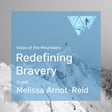Become a Creator today!Start creating today - Share your story with the world!
Start for free
00:00:00
00:00:01

Acclimatization Strategies, Part 1: Foundations and Moderate Altitude
In the first episode of a two-part podcast, Alyssa and coach Martin Zhor, dive into an overview of acclimatization strategies, with particular focus on moderate to high altitudes. They break down how and why the body adjusts to altitude with specific responses and the short and long-term effects. They also discuss training and racing strategies to manage the effects of altitude within recreational and performance situations. Martin offers advice on how to support goals in higher altitude environments and common mistakes athletes make. Tune in to help your lofty goals become a reality.
Check out more information here: https://uphillathlete.com/mountaineering-training/
Or write to us at coach@uphillathlete.com
Transcript
Introduction to Acclimatization Strategies
00:00:00
Speaker
Welcome to the uphill athlete podcast. We are here to educate and inspire all mountain athletes. I'm joined today by Martin Zor, who is our one of our resident altitude experts. And you've heard him before on our first episode of acclimatization and also well, I guess altitude acclimatization and also on a few other podcasts talking about altitude.
00:00:37
Speaker
Martin, thanks for being here today. Thanks, Alyssa. I'm glad to be here again talking about Altitude, one of my passions. So let's talk today about this specific topic about the strategies. We decided to break it down into two chapters.
00:00:57
Speaker
Yeah, so we are going to be diving into specific acclimatization strategies. And we are going to focus on what would we say, like low altitude to kind of like high or how moderate? Yeah, moderate, high altitude. And then the next time we want to talk about the extreme altitude, so anything about 5000 meters.
00:01:24
Speaker
Yeah, I said low and then when I don't think low is the correct term that we want to use for that. And we did talk about these different moderate, high and extreme in our first episode, but we're going to revisit them to help with specific strategies because they are different and they require different
00:01:48
Speaker
uh, skills and, um, strategies for lack of a better word, uh, for these specific areas.
Understanding Altitude Categories
00:01:55
Speaker
So let's get into, uh, our first piece, which is why do we need to acclimatize and how do we choose a correct strategy for what we're trying to do? All right. So these questions I try to, uh,
00:02:14
Speaker
answer through studying or doing my research with my school, of course. But people, I guess, approach us also in uphill athletes to really understand do they at all need to acclimatize when they have their objectives. So I think it's important for us to start with the category. So low altitude or coming from sea level to low altitude and moderate altitude. Last time in one of those podcasts we did,
Importance of Acclimatization
00:02:43
Speaker
So we set those levels to, let's say low altitude, I would say anything below 1800 meters, which is basically just a low altitude that doesn't really create any significant effect in the body. And so for majority of people, you don't really need to worry about that.
00:03:06
Speaker
You don't need to worry about getting sick. You don't need to worry about your performance changing or being affected to a large extent. So that's low altitude. So then the next category is moderate altitude and maybe high altitude slash because we can
00:03:23
Speaker
maybe talk about this category category today all together so anything about this level of thousand eight hundred meters somewhere to five thousand years so whatever is it you can translate it to feed for our audience.
00:03:41
Speaker
Yeah, that would be 3,000 would be around like 11,000 feet and then 5,000 meters would be about like 17 to 18. Does that sound about right? Yeah. Yeah, 16, 17. I think because I know it's like 30, 30, 30 something. Yeah.
00:04:04
Speaker
It's kind of like, I always use three as the base point, but then I know it's more than three feet per
Physiological Changes During Acclimatization
00:04:11
Speaker
meter. So it's like 3.3 ish. So I always add in a little bit extra for that. Yeah. Yes. Yeah. So just to specify, why do we use these, uh,
00:04:23
Speaker
benchmarks or these thresholds, maybe even so, as I was mentioning, the 8,800 meters is really not significant enough to cause any effect. So we don't need to really worry about it. And then maybe the next level, the 5,000 meters more or less, let's say, is really a level where most people can acclimatize to because it's quite a significant
00:04:48
Speaker
level then, of course. By the way, on the big mountains, this is a level where you find your base camp. For example, Everest base camp is 5,300 meters. You already need to consider this altitude and prepare for it to acclimatize. The process of acclimatization is what we will talk about. We already covered it a bit in the last podcast.
00:05:14
Speaker
What is important to know that most people can get there with the process with time and then why do we need to acclimatize? So we need to answer those questions.
00:05:29
Speaker
First of all, with altitude, with increasing levels of altitude, it's really challenging for the body, to the physiology, how our bodies function. And so if we go too fast, too high, too altitude, we can develop
00:05:47
Speaker
illnesses. So the first, first, you can feel some symptoms like headache, nausea, dizziness, and others, a loss of appetite. But then if you really are not really respecting that increasing
00:06:02
Speaker
increasing increasing level progressively, and you go too fast, you can actually get sick and seriously sick. So the first sickness is called acute mountain sickness. And then if you actually are not respecting or you just kind of in trouble or for different reasons, you can develop the more severe versions of this and there are
00:06:22
Speaker
the high altitude cerebral edema or pulmonary edema. Those are very serious, of course, which we can lead to death. This is actually the primary to answer your question, why do we need to acclimatize? As mountaineers or trail runners, climbers, we try to acclimatize to actually avoid getting sick.
00:06:44
Speaker
course to stay healthy and to avoid this. Then the second important factor is
Tailoring Acclimatization Strategies
00:06:51
Speaker
that the higher we go in altitude, our performance suffers. It definitely affects
00:06:59
Speaker
the way our body functions, the physiology, and specifically to the performance. So by acclimatizing, we are actually trying to at least maintain, to some extent, our performance, or to some level even increase it.
00:07:15
Speaker
Then it of course depends which category we are talking about, if it's the moderate, high or extreme altitude. But we will this time talk about the lower levels. But when you think about the high mountains, you really want to actually get there, get to the top because the altitude has that effect. It actually really slows you down. Your body is under such a huge stress that it's really becoming very challenging to just walk
00:07:42
Speaker
or just to climb step by step. And the higher you go, everything's just slowing down. So that's the second big objective or purpose of acclimatization. But then the adaptations that happen through the acclimatization process, actually what we noticed or athletes have noticed that it can be actually
00:08:09
Speaker
helpful when you come back down to the C-level or low altitude. Some of those adaptations are actually optimizing performance or actually enhancing performance to some level. So we can talk about those. And other purpose maybe just to mention is rehabilitation. So if you're an injured athlete, there are nowadays ways to go to
00:08:33
Speaker
to hypoxic chambers or hypoxic gyms where you can actually do your training with some level of altitude which is simulated through some generators and by doing that you're actually basically either you can do your training in a
00:08:51
Speaker
lower intensity but because you're breathing the hypoxic air you're kind of equalizing that so you're actually increasing the effect of the training by doing it at altitude or you can just do a shorter training instead of doing 60 minutes you can do maybe 30 40 minutes for example
00:09:10
Speaker
Which means that in a rehab process this is important if you try to return to your activity you try to get stronger and so this can definitely be a part of your rehab process so it's already used there are commercial gyms that have this kind of equipment.
00:09:30
Speaker
Oh, that's, that's super helpful. And I think, you know, we throw around the term acclimatized so often we understand it's really important, but it's really helpful to hear the exact specifics of why it needs to happen. So then, now that we've established why, I think this is where you come in, in such a helpful manner for so many athletes is
00:09:55
Speaker
we have athletes that come in like, okay, I know I have to acclimatize, but I don't know how to choose what that strategy should be. So how do you help an athlete walk through choosing the correct strategy for their objective?
00:10:10
Speaker
Excellent. That's a great question. The way I start is actually asking more questions. That really is the part of the intake process with the new clients, whether it's the acclimatization strategy or if it's the actual training. You need to really try to find out a lot about your client, about the athlete.
00:10:33
Speaker
So where you want where you are right now so try to try to find out about the fitness levels etc and then okay what is your objective is it the race is it mountain is it some kind of challenge endurance challenge that's usually the case with our clients and athlete.
00:10:51
Speaker
And how long do you have to actually prepare? So then we have some kind of information. We have a point A and point B, how do we get there? And then if the objective includes some kind of altitude, then I get into the research and see what's involved. So what are the factors?
00:11:10
Speaker
that we can actually do something about with the train and if the altitude is the part of it right so then of course with what is the level is it two thousand three thousand all the way to Everest the Everest level right so then it gives me some kind of ideas and do we have enough time to prepare for this objective and
00:11:31
Speaker
Where does the client, where does the athlete live? Close to the mountains, far from the mountains, sea level, even below sea level in New Orleans, places like that, they are actually a bit below sea level. And so it's challenging, of course, but it's possible and there are people over there that actually are preparing for big mountains and so there are ways.
00:11:54
Speaker
for them to be prepared and so we can discuss these. But this is really the way I work. I'm trying to really get into the, to get as much information as possible and then set the strategy. Do we have enough time?
00:12:09
Speaker
what needs to be done already to prepare the athlete with the fitness to be fit enough to then get to the mountain and be strong enough and have enough endurance, et cetera. But also, where does the acclimatization fit in? And of course, then the different levels of altitude require different strategy, different time to acclimatize.
Balancing Training and Acclimatization
00:12:34
Speaker
And then, okay, when I have that information, how do I get there? What will be the time of the expedition, for example, if it's a mountain climb?
00:12:45
Speaker
But then there are situations like mountain races, trail races, right? So some of them happen at altitude, significant altitude, let's say, a dozen, 3,000 meters. Some of them hire ski mountain races that are sometimes, now we're talking today. So this week, there is a big race happening in the Alps, Patrieu de Glossier.
00:13:09
Speaker
which goes from Zermatt to Berbia. It's a very famous race. And so the athletes go from Zermatt, which is 1,600 meters, over a past 3,600 meters, and then go more or less about 2,500 meters all the way. But still,
00:13:28
Speaker
this is a high-altitude so it will definitely affect the performance affect the fatigue recovery and there's a quite a tough time cut so that's what the athletes are mostly concerned about whether they make it through the house point and to the end within that time frame so of course some of them they live in the mountains for them it will be easier to acclimatize, prepare specifically for the altitude
00:13:57
Speaker
But some of them, actually, maybe most of them, they don't have that luxury. So then, of course, comes to create a strategy to what to do about it. And then it comes with really, how much time do you have? What resources do you have? And the possibilities to travel. But nowadays, and we will talk about this later, there are actually ways to acclimatize, pre acclimatize also at home.
00:14:26
Speaker
Oh that's fantastic and I think that's probably the best coach answer to say is the way that I start coming up with the strategies to ask even more questions because I think that that is a lot of our job is asking more questions to get more information to also help realize truly what's realistic because
00:14:48
Speaker
You know, I will get into this more. There's obviously very ideal ways that you can acclimatize. And then there's I can't get to the mountains or I live at sea level or these are my limitations, whether that's monetary time, family commitments, et cetera. And so part of the individualization is the fact that we are working
00:15:12
Speaker
for like working with you, not just saying, hey, you have to go move to Colorado for the next four months. So yeah, yeah, sometimes it's actually the case some some some
00:15:25
Speaker
Yeah, which is amazing. Yeah. If they have these options, consider that we go and I'm super happy as a coach, of course. But usually it's a great point you're saying here. And the way I look at these things is actually the usually cost and benefit perspective. Right. So
00:15:44
Speaker
We definitely want these benefits, but how much will it cost you? So, the cost obviously, financial cost, the time spent away from your job, from the family, and logistics, and actually to some point where you can maybe, it will actually reduce your capacity to train, so then you actually have to consider
00:16:05
Speaker
how much is it actually important and maybe it's just important to be at home be comfortable have a capacity to train prepare as best as you can the fitness the physical fitness will always be if not the biggest factor within the the mountain sports that we that we can go with with enough right so the mountaineering.
00:16:26
Speaker
or the trail running or ultra endurance events. So physical fitness is always your biggest asset. But where we talk really about the acclimatization and trying to see how much of a factor that is and what we can do about it. But I think to look at it with that perspective of cost and benefit can help you out and maybe
00:16:50
Speaker
Sometimes you should even bring that anxiety down. Just try to calm down. Okay, I can do this or I don't so I will just focus on getting fit be healthy and get to the start line as healthy as and fit as possible. Yeah, I think that that that anxiety is such a great point because I do think like I say this all the time to my clients just a normal training where I say I don't want to
00:17:15
Speaker
to be getting up at 4am every day in order to get your training in because that's not a sustainable way for you to live.
00:17:23
Speaker
And if, yes, obviously there's times that we make compromises, that we stretch ourselves within our training, we're doing uncomfortable things, but it also has to be somewhat realistic and not push you to the point where you're sick, injured, not actually being productive with those changes because you've extended yourself too far.
00:17:46
Speaker
So I think that's why it's so important to work with Martin to work with, you know, a coach who has this knowledge and is able to make a plan that you don't have, like, yes, you have to make adjustments, but you're not shoving your life into a one size fits all.
00:18:03
Speaker
I think so. It's a great point and something I would like to talk about is really what the cost of acclimatization is actually real. The physiological stress coming from the process of acclimatization is real and definitely you need to be aware of it and consider it.
00:18:23
Speaker
Again, the strategies come from, do I need to acclimatize for my project? If I do, then I need to know how long do I need for this acclimatization? And then the next point I need to really make sure that the athletes understand is that
00:18:39
Speaker
it cost you physically it's a process for the body and so i need to acclimatize i need to go through this process but i need to also know that my recovery will go down i will go through a lot of stress so my training will suffer to some extent i will have to really adjust my training volume training.
00:19:01
Speaker
whether it's intensity, volume or both, doesn't matter. But I really need to be aware that I'm actually overreaching. But I really need to know that I do this for a good reason. So I think actually in this chapter or in this podcast, now we will talk about the lower levels of altitude, the moderate and high altitude.
00:19:23
Speaker
There are definitely coaches out there that actually tend to not suggest or recommend to acclimatize if you really don't have that option because it just costly, it's logistically difficult and the time you need to actually spend that attitude is quite significant to really get those
00:19:41
Speaker
important adaptations. So sometimes it's actually just better to skip it and don't acclimatize at all. That's just actually arrive in the day or two before the race and just show up and basically go and hope for the best. Knowing that there will be some limitations, knowing that you will go through some tough times if you pass through different portions of the race or whatever it is in your objective.
00:20:10
Speaker
But i guess that's really important to know to ask us coaches or specialists for altitude to really consider those options and give you a clear idea okay you're going for this objective so we can make this plan with the possibilities you have but i guess it's very important to also know then,
00:20:31
Speaker
The higher you go, about 3000-4000 meters especially, the risk of actually running into the trouble of getting sick really, really suffering because of the altitude is getting higher and higher.
00:20:44
Speaker
Another important point is it's very individual, so some people will suffer, some people will suffer less or suffer not at all actually at some level, so very hard to predict. We still don't have or have very limited ways to assess this at this point today, but hopefully in the near future we can change this, we can actually do some testing and give you a good idea about your
00:21:12
Speaker
rate of acclimatization or the way your body can deal with altitude. I think it will be super helpful and people can really appreciate it because then you can really consider, okay, is actually the altitude a factor for me or I don't need to care. Right now it's quite difficult.
00:21:29
Speaker
I think then it's really coming also to trial and error so getting more experience you will be able to say okay I don't need to acclimatize for you TMB I'll be fine at 2700 meters in the mountain passes so I can just do my training back at home for other people is like I really suffered last time so I actually will come to Chamonix one or two weeks before and spend some time up there at altitude and so that the altitude doesn't become a limiting factor for my performance.
00:21:59
Speaker
Yeah, and I think that's so key. I know this has been talked about many times of the importance of training and the importance of putting yourself in positions where you can gain that knowledge. Because if you don't, then it might be at the moment of
00:22:17
Speaker
for trail running the moment of performance where you need to be at your best or it could be in the instance of mountaineering or alpinism where it's a safety issue. And so the more that you can expose yourself in situations that have some safety nets rather than the moment where you must perform, I think the better off
Barometric Pressure Effects
00:22:44
Speaker
you are.
00:22:44
Speaker
No, I think it's, yeah, I agree. There's definitely, I mean, we now talk also about those distinct categories. So maybe that's what is important to mention. The moderate altitude, let's call it like 1,800 meters all the way to maybe 3,500. And where probably it's not the exact number, the actual numbers, we can mention that actually later. We just spoke about it between the two of us.
00:23:10
Speaker
it really depends where you are on earth because the the altitude is actually or the way our body functions is actually a function of barometric pressure so the higher you go at altitude the barometric pressure goes down and it actually is affecting our body the way the way we can get enough oxygen into our bodies so that's actually a function of the pressure not actually the altitude
00:23:36
Speaker
and so what is important to know as well is that the pressure atmospheric pressure is affected or works as a function of temperature of air so the colder it is the lower the pressure even lower i mean so on the equator on earth it's it's warmer so the attitude will actually feel slightly less demanding or challenging than when you go
00:24:04
Speaker
to the south or to the north so Denali is a mountain very far north or Winston in Antarctica is obviously very far south so even those mountains are. Well they are quite high but let's say Denali is about six thousand two hundred meters it actually feels for the alganis that have climbed up there they know that it actually feels much harder than that so this is the reason why.
00:24:30
Speaker
No, just to build off of that, we actually had that discussion in the podcast before this one with Bill Allen where he's done a lot of guiding on Denali as has Steve, where they were talking about how the altitude is more challenging in Denali.
00:24:48
Speaker
And so you gave, they had ideas, I think, very similarly to what you said, but it's nice to hear the actual concrete facts behind that. So thank you for adding on to a piece from a previous podcast you didn't even know about. We've cleared that up. It's actually quite fascinating. And it's the research that actually clarified that for me too.
00:25:13
Speaker
there are actually some nice fun facts about it. And I think I actually mentioned this before in the podcast, but one fact is that if Everest, which is at 30 degree latitude, was further
Strategies for Lower Mountains
00:25:26
Speaker
to the north, let's say on the Europe where I live in Chamonix, which is about 50 degree latitude, so we would not be able to climb Everest without oxygen. The barometric pressure would be so low that it would just be impossible just even
00:25:43
Speaker
So let alone be active. So quite fascinating. So the barometric pressure again is the important factor actually that is changing with the increasing altitude. But I would like to actually talk about the lower mountains. So mountains like Rainier, Kilimanjaro or Mont Blanc here in Chamonix.
00:26:07
Speaker
So those mountains are, let's say, kind of on the borderline to high altitude or the top of the high altitude category, let's say. So I would say there is, on these mountains, there's already some risk of getting the altitude sickness if you really push it too fast or you're just kind of individually susceptible to get sick.
00:26:29
Speaker
But the way these mountains are usually climbed is actually quite interesting for me as just being a climber, alpinist, and living in Chamonix, but also a researcher, because also the acclimatization process takes a certain time. The adaptations that happen from the first minutes in hypoxia to then with days and weeks and months, obviously some of them really take a long time. So let's say within the
00:26:59
Speaker
moderate and high altitude category of mountains. Some of them you actually climb within maybe three, four, five days. Sometimes people come here to Chamonix and they climb in Mont Blanc within three days. And they are not acclimatized at all. And some of them are actually getting sick already. They hit a hooter hut and slightly above, let's say 4,200 meters and actually they have to be helicopter and rescued and they have to go down.
00:27:25
Speaker
Well, logically because they just didn't spend enough time to acclimatize. But what is interesting is that what they call acclimatization or the companies that offer these climbs is maybe four or five days.
Body Adaptations at Moderate Altitudes
00:27:38
Speaker
So now that I can talk more about the adaptations and how long they take, what I tell my clients often is that you will be leaving the mountain, you will be going back home and you're actually still not acclimatized even.
00:27:52
Speaker
So the process is still kind of somewhere in the middle. But what happened was that you adapted enough to actually get up there that you were actually able to get there without getting seriously sick and you were able to maintain to some extent to some extent the Arabic performance. But let's say we want to talk maybe more about the
00:28:14
Speaker
moderate altitudes the lower lower portions where you already getting some effects of altitude on your body and you definitely want to know about the strategy how long you want to spend there and then you really want to go down to sea level and you want to perform you want to have the high hematocrite high hemoglobin and all these all these factors that that athletes are after.
00:28:40
Speaker
Are you ready to achieve your mountaineering objectives and perform better at altitude? Right up the Lassie, you can train your way with our field-tested, science-backed training programs. Choose from training plans, personal coaching, or the new uphill Lassie training membership. Check out the link in the show notes and start training.
00:29:00
Speaker
Yeah, so I think that that goes back to what what is the goal coming out of your acclimatization strategies that you're you're targeting. Martin, do you want to touch on just briefly because we have talked about adaptations before, but do you want to review just a few pieces of what these adaptations are in the body and then we can dive into the specificity within moderate altitude?
00:29:29
Speaker
Yes, definitely. I think it's worth to talk about this again, but very briefly. So when we get to hypoxia, so the reduced amount of oxygen in the air that we breathe. So our body we breathe in the air and
00:29:46
Speaker
So our body has a way to sense it real fast within minutes. Our brain actually finds out that there's a certain lack of oxygen in the air. So the adaptations that happen are really fast within minutes. So the first are the hyperventilation and increased heart rate.
00:30:05
Speaker
So, both are actually functionally a way to provide just more and more oxygen into the body, into our tissues, because we really need oxygen continuously. Our brain needs oxygen. Our muscles need oxygen to be active or to just kind of be or even resting, right? So, this adaptation is acute. It really happens within minutes and hours. So, our heart rate goes up and our breathing gets deeper, but also
00:30:35
Speaker
you're kind of breathing at a higher rate. But then at the same time, there is a huge cascade of changes and adaptations that is very complex. There are molecules in our bloodstream, in our body that get produced or that just kind of appear in the large quantities. They are called hypoxia and usable factors, very important.
00:30:57
Speaker
thing that was discovered actually several years ago only and this actually these molecules just kind of spread around the body and they are like signals to different parts or functions or organs in our bodies that actually do something. So basically the acclimatization is really about that. Sometimes we only focus on the hemoglobin, the
00:31:20
Speaker
which is actually enhancing or improving our oxygen carrying capacity. That's as athletes, so we are familiar with that. But actually, it's a very complex response, which is affecting really different parts.
00:31:36
Speaker
But what is happening, and what I'd like to actually talk about is how long these things take. So if we stay at altitude, if we keep acclimatizing, so the first minutes, hours, and let's say a couple of days, the heart rate goes up and the heart of ventilation. Also what is happening is di-resin, so we actually are losing the liquid part of the blood, so the fluids.
00:32:00
Speaker
So the body is trying kind of artificially to increase the density of the blood by reducing the liquid part, basically. So it gets more dense, but it comes at a cost because then the heart sort of needs to work harder to push that blood around. But, well, the body works that way. But I would say you can already sense it or maybe you can already imagine a higher heart rate.
00:32:28
Speaker
You breathing more so it's sort of resembling a stress reaction when you're stressed you're actually your heart rate goes up your your chest is pumping your breathing more and maybe without realizing but it actually is a stress that's that's that's the important part that is really important about all the climate ization.
00:32:50
Speaker
It is quite a, quite a stressful process, especially that first, let's say week, two weeks. And of course if you stay at altitude and actually go up altitude, um, then to, let's say higher mountains. I'm not saying that it's less stressful, but actually what is happening in the first days, these first adaptations started to come down. So the heart rate to some extent, not exactly, uh, to the sea, to the sea level at the level, but, uh, it comes down, it comes down hyperventilation as well.
00:33:20
Speaker
because the other adaptations then take place and help you to acclimatize better. So you don't need those first, the acute ones. And that's a good thing because you really don't want to be having heart rate 100, 120 when you're going up at altitude or you're in your training camp at a dozen, 500 meters or training for your train rates or something. So you definitely don't want those, but they are super important in that first part. So what is actually happening then?
00:33:50
Speaker
Mainly the big part of the acclimatization is of course actually trying to increase the hematoprite, so increase the number of red blood cells that is actually improving or increasing.
00:34:03
Speaker
um, your capacity to carry oxygen around your body. Uh, so that one is actually taking from days to weeks and actually keeps going up. Uh, I think it's about 1% on average 1% increase in a hundred hours. Every hundred hours it's increasing, but it also depends on many factors already individual. Some people have a larger capacity to, to pre-approve, to increase their, uh, hemoglobin count.
00:34:32
Speaker
But if you're actually staying at altitude for many months, this process is still increasing. And I think it kind of stops around eight months. That's what's been observed. But that's usually not the case for most of us. We don't stay so long. If you actually are then staying for a couple of weeks or even months at altitude, sometimes that happens in expeditions or other cases.
00:34:56
Speaker
Your body is also trying to help this process of getting that oxygen, which is in the lesser quantities around you. So actually you're creating more capillaries. So capillaries are really the smallest blood vessels that are circumnavigating or what do you call it, that are around your tissues.
00:35:21
Speaker
circulating our tissues and specifically when it comes to activity and training our muscles. So actually you are improving your capacity to bring nutrients, but oxygen mainly to the muscles quickly and more efficiently.
Race-Specific Acclimatization
00:35:36
Speaker
And so it's actually one of the byproducts or one of the factors that gets improved by the acclimatization process. But you see what is important to know is that from the first adaptations, those take minutes and hours.
00:35:51
Speaker
Then to the adaptations that really need some time, you need to really spend some time at altitude to create those. Once they appear, the others kind of disappear or don't need to stay there. It's a huge complex process. What I'm trying to stress this, the timeline, is that it's really important for me then to know when I'm trying to create a strategy for an athlete.
00:36:18
Speaker
Let's talk examples, let's say, Utra, Trey, Montblanc, UTMB race, right? So it's a race where you start at a thousand meters in Germany, then you have to climb some mountain buses, which are somewhere like 2000 meters, 2,700, I think is the highest point if you do that big loop. Uh, but actually then the time spent for a regular athlete, it's actually probably one
00:36:43
Speaker
short portion of the race that you will actually spend above, let's say that 1,800 meters, that, that threshold we talked about before. Right. So then it's really about determining is that actually is such a big factor that I need to stress it about this. So what is actually happening often that people are, Oh, I need to acclimatize. They come four or five days before the race and they just don't let them, they take the lives. They go up to 3000, even 4,000 meters here with the equity middle lift.
00:37:10
Speaker
And they just go crazy and they run it through 2000 meters and what are they actually doing? We just talked, I just talked about those adaptations. They are actually creating a lot of stress, stress in the body. So that's the first four, five, six days that are actually.
00:37:26
Speaker
I'm not saying most stressful, but very stressful in this long process of acclimatization. So are they actually doing something that will benefit them? To some extent, yes. But actually, maybe they are just doing too much. It's just too much additional stress. They probably would be much better off to just rest, maybe just to arrive day or two before the race.
00:37:50
Speaker
And just to be ready and just hope for the portions of the race, they will run about 2000 meters. They will actually be okay. Maybe they will lose 30 minutes of total time or maybe one hour, but maybe it's actually better than.
00:38:07
Speaker
just going through this like four or five days, going crazy, running at 23,000 and actually going through this very stressful process of the first days of acclimatization. So it's actually a huge deal and it's been studied. It's been definitely studied in research. And so actually the recommendations for this specific case of races like UTMB.
00:38:28
Speaker
is either you really arrived enough time before, so you actually have time to acclimatize. But this can actually, within the timeline of those adaptations, that is probably minimum one a week, six, seven days. Or you actually arrived the day before and you just have a relaxed day, deal with jet lag, have a good sleep, and then go for the rest.
00:38:50
Speaker
But then there are maybe races that are, I think it's Hardrock or Western States. I'm not an expert here, but it's actually quite a hard rock that you actually run close to 3,000 meters almost away. Yeah, so Leadville and Hardrock, you are above, you're at least above like 2,700 meters, I think the entire time.
00:39:13
Speaker
topping out well above 30 to 3,300 meters. Yeah. So it's the entire race year above. Yeah. You're definitely in that moderate altitude zone. Yeah. Yeah. So you see, having said all of this, I would say that if I have someone approaching me that wants to do this race, I would definitely try to talk about the strategy, how to acclimatize. Right. So
00:39:42
Speaker
Another thing is also you want to acclimatize basically to be at altitude, but then also here we talk about performing at altitude, so it's another level.
Metabolic Adaptations at Altitude
00:39:50
Speaker
It's also very important adaptations that happen in your muscles, in our cells energetically, like energy metabolism, I mean, that are affected by hypoxia. And you definitely want to give some time for the body to adapt to working out, exercising at hypoxia, or being a high-performance athlete.
00:40:11
Speaker
you definitely want to go after these like marginal gains, right? So I think altitude is one of them. So again, trial error, you already should know how your body is reacting. But yes, in this case, you see there's a bit of a difference between unity and be at these races, most of the race you will actually be at that altitude. And so it's a factor that you should consider to address. Yeah, I think that's very interesting because
00:40:41
Speaker
I would say a lot of people tend to think of UTMB as a quote-unquote altitude race and I always say not particularly because you're spending such a small portion of your time really at that
00:40:54
Speaker
critical altitude zone as you were talking about versus the ones in Colorado where you are the whole time up there. So I think that's an excellent point. I think it's like we discussed before. So it's a perfect example of
00:41:12
Speaker
There's always a trade-off for everything so of course i prefer if you come and be climatized but that will also cost you it will cost you money it will cost you time and so that's time is actually something i really wanted to stress about. How long it actually takes how long do you need at least for this basic.
00:41:30
Speaker
Basic acclimatization then if we talk about the you know races that are ski mountain or in races or climbing on one i think that's that's also very different but let's say if if it's you can be around first day with such a long event which runs there the factors that you need to cover are like primary is the fitness right you really need to be ready. Your training all those months before needs to be needs to be top and the nutrition and sleep and.
00:41:59
Speaker
strategy for basing et cetera but let's say if the altitude is like for sure a factor in performance so it's good to have that conversation and just based on your possibilities for traveling either it's possible or not so then knowing just to have that answer if the client asks should i excellent eyes if you have this information you can already work a bit better. Another another thing actually what i would like to.
00:42:28
Speaker
mentioned here is that stress that you go through in that first, at least that first part of acclimatization is that you definitely need to address your taper, right? So taper is maybe something we already covered in the previous podcast. So it's the period before your objective or your race, where you basically try and reduce the volume. So
00:42:48
Speaker
to bring this super compensation in your performance so you really try to reach the fatigue and you're trying to improve your form so the factors you can sort of monitor in training peaks, the platform, the software you use for coaching, for training. Physiology is a real thing, it's been proven that it's important. Why I mention it or talk about it here with altitude is that you see that the altitude
00:43:18
Speaker
The adaptations happen within certain time quite fast but then if you go away from the altitude back to sea level or low altitude you start to lose them the body will not keep what it doesn't need and in case of altitude adaptations that happens too and so you need to consider that too so if you have a client that asks okay i'll be in altitude month before but is that okay so i say
00:43:45
Speaker
Well, it will do something, but probably most of those adaptations will actually disappear. Them hematological adaptations probably will be gone. Usually the estimate is weak, but probably two weeks after two weeks, you probably lose most of them or you starting very quickly to lose most of them. So two weeks is a sort of a borderline. So that's also something very important to consider.
00:44:07
Speaker
I'm coming back to the table so if you choose to acclimatize just before the race you need to also be aware of that stress right so.
Training Specificity for Altitude
00:44:18
Speaker
Either you have to make the table longer right so that you make sure that you actually have enough fitness students so you can actually afford to cut the training volume even before two weeks like two weeks earlier or.
00:44:33
Speaker
Like longer than that, I mean, or, you know, there are different scenarios, but it's quite a challenge to make all these things happen. And again, it comes to that great, to the good analysis of the objective. How much is it important to acclimatize for your race, for your mountain, for your climb?
00:44:52
Speaker
Yeah. No, there's just so many factors that are, you have to take into account and it's not just, oh yeah, let's show up a few days beforehand because it doesn't work very well that way. Yeah. I think, uh, yeah. So let's get into specificity of what are you training for? Is that you want to, do we want to touch on that next Martin with the live high train high? Yeah, again, I,
00:45:21
Speaker
It's kind of what we've already talked about anyway. I'm trying to really stress the importance of, okay.
00:45:29
Speaker
What is altitude? What is acclimatization? How long does it take? How is it important for your objective? So within this chapter today about moderate and high altitude, so something between 2,000 meters, let's say, to put it simply, to 5,000 meters. So there are actually different strategies that are actually called funny names, let's say, that it's basically live high, train high,
00:45:59
Speaker
Live high train low live low train high and actually one more which i would like to actually cover here because it's important so let's start with that moderate altitude so. The way it all started maybe with the altitude training why people actually started to.
00:46:17
Speaker
Go to altitude and do some some trading games there is started with all the games in mexico in nineteen sixty eight. Why because mexico city is in a quite a considerably higher things about two thousand five hundred meters i'm not mistaken.
00:46:33
Speaker
Anyway, most of the events, specifically the endurance events, were held at that altitude, which definitely affects and definitely for these Olympic athletes at the top form, at the highest level. Of course, you really want to get the most.
00:46:50
Speaker
to be there the most prepared and be the most competitive. So, actually, then, athletes, they chose either to live there, to be there a month before, or they were trying to actually bring some strategies, and there was not much research done on this topic before that. And so, it was a lot of trial and error or somewhere. Some went right, some went wrong, but definitely since then, people started to realize that something's going on.
00:47:16
Speaker
So of course you were trying to acclimatize for that performance at the moderate altitude, right? So specific altitude. But then what they also noticed was that the adaptations after spending some time at altitude training and
00:47:32
Speaker
what's the climate is in but actually performing attitude they went back down to sea level and their performance for the deposit in house at least for several weeks do you have a little bit was increased which actually directly affects your real max maximum arabic capacity. The amex definitely improves with with increased amount of right so that's why also.
00:47:53
Speaker
Unfortunately that's that once that let into doping so people are to protein when it's actually injected artificially or how do you call it it's actually a hormone that is secret that is produced in the body natural and specific adult attitude right that's the.
00:48:10
Speaker
That's actually the one of those first responses that then offsets the production of red blood cells but that production actually takes quite longer so we need to wait for it for a week or two until it starts to really make an effect on our body.
00:48:26
Speaker
So the athletes can actually of course use it in their sea level performance. So then we already talked about the strategies like live high, train high. So you really are at altitude camp or you live in the mountains or you just go to acclimatize for your mountain in the country.
Simulating Altitude at Home
00:48:46
Speaker
So let's say like Everest base camp.
00:48:48
Speaker
It's a track, you're tracking from 2,000 meters all the way to Everest Basecamp, which is at 5,300 meters, so sort of at that borderline we talk about today. And you actually are taking your time, you're actually going gradually slowly to that altitude, and it probably will take you 10 days at least, if not two weeks, to actually get safely to that altitude. So you just spend the time, live high trainer,
00:49:18
Speaker
What is actually another way, next strategy, is the live-high framework.
00:49:30
Speaker
Different scenarios, so athletes that are really high-performance, they are going to places like, I don't know, Albuquerque, New Mexico, Flagstaff, Arizona. Here in Europe, we have San Moritz or Davos, the place where you can stay easily in a hotel at a more or less 2,000-meter altitude and do a really good quality training.
00:49:52
Speaker
What is the problem also if you already know your Arabic performance suffers your quality the quality of your training will.
00:50:02
Speaker
decline, more or less. And of course, for these high performance athletes, when they are really at the cutting edge of performance, and they really try to be competitive, this can be quite an issue. So what they actually started to do was their sleep, and they spent the day up there in the training camp in LG, and then they drive down to 500,000 meters down.
00:50:26
Speaker
lower down and they do their training workout actually at lower altitude, we're in the full amount of oxygen, making sure that they are really fast and they really can get that quality into training. Then they go back up and keep acclimatizing, do that for two, three weeks and then they go to compete. So it's one way to do it.
00:50:49
Speaker
Next strategy is low limo train high. So I would say the case where I live in Chamonix, which is 1,000 meters, I don't think it's considered even high altitude or moderate altitude. It doesn't really have so much effect, I would say. But you actually have a really easy way to taking the lifts who basically go to almost 4,000 meters, taking a gilded metal lift here, which is famous. And you are at almost 4,000 meters, 20 minutes, 30 minutes maximum.
00:51:18
Speaker
And you can climb, ski, train, run, if you choose to climb on one, climb different routes and just be up there actively. Right and then you take the life down and come back home for lunch. So it's a great way to train of course at altitude, but you actually live low. So it's one way to do it.
00:51:37
Speaker
Or you really have clients that, or we have athletes that live in the cities, but they really have mountains within driving distance. So if they have that option, I definitely encourage them to do that. If they can go spend time at altitude and do some specific training, of course it's a great way.
00:51:57
Speaker
Is that enough? How much do they need? Of course, I already talked about it today. How much time you actually need to bring enough adaptations. So many questions first. What is the objective again? What is your objective? Based on that, I will be able to tell you, yes, it's enough if you go to the mountain once per week. Or not, you have to just try to spend more time
00:52:26
Speaker
in hypoxia or in altitude. Maybe one last category is live high, trade low and high, so it's kind of a combination. Basically, that's where you want both. You actually are maybe trying to acclimatize for a climb, for a mountain.
00:52:48
Speaker
or even for some race, ski mountain, race, FKT, attempt on a mountain. And so you have a way to be actually at altitude, but also you just basically do some training in the sea level or low altitude. Or it's also a case with normal barring hypoxia. So it's maybe a chapter we can quickly cover here. Basically,
00:53:17
Speaker
for people at least that have no access to the mountains. Nowadays, we also have ways for them to acclimatize at home. So there are companies that are offering generators that actually simulate altitude. So maybe Alisa, that's the next chapter we can talk about. Yeah, yeah, let's get into it. So thinking
00:53:42
Speaker
about, I think that this is probably one of the, probably one of the questions you get the most. It's a question I get also from athletes is like, Hey, I've heard about this, sleeping in a tent, neurobaric altitude, what is that? And how do I know how to use it? So would love to hear your perspectives on it. And
00:54:08
Speaker
We'll stick with, I mean, of course expand into high or extreme altitude as needed, but how it would be useful for moderate altitude.
00:54:17
Speaker
I think it's just worth mentioning what it actually basically means, these hypoxic tens. We are actually talking about hypoxia, which is normal baric. So comparing to hypobaric, which is lower pressure, so we discussed that, the lower atmospheric pressure, the higher you go at altitude, real altitude.
00:54:40
Speaker
So what is actually happening with these generators is that they are creating the hypoxia by changing the ratio of molecule oxygen molecules in the air usually it's a dance you actually have a dance you sleep in or spend some time in sometimes they are actually commercial gyms that are using these generators.
00:55:02
Speaker
So you have a limited space with some machines, exercise machines, but what is actually happening is that instead of 21% of oxygen molecules, you're reducing this percentage, the ratio of oxygen molecules.
00:55:20
Speaker
So the pressure is staying the same, the atmospheric pressure, but you are basically reducing the oxygen levels artificially by increasing the nitrogen levels. So nitrogen is the one that is most prevalent, so it's about 80% of oxygen or more.
00:55:40
Speaker
molecules in the air around us is nitrogen, the next is really close to 21% is oxygen and then very small fraction is the rest of the different gases molecules and this is actually the same on sea level and this is the same top of Everest actually, still 80 to 20% nitrogen oxygen.
00:56:03
Speaker
So it's really the density that is reduced when you are on top of Everest. It's about 30% of the value of sea level. So it's quite remarkable, very much lower than. Of course, it affects your Arabic capacity, everything. That's why it's so difficult to get to Everest without supplemental oxygen. But back to the normal barracks.
00:56:30
Speaker
These generators actually we can use nowadays, back now, in our homes, with tents. As I was talking about the timeline, how long does it take to acclimatize, it's very important to know that. In order to acclimatize with the help of the generator, you can imagine that it's quite annoying actually.
00:56:53
Speaker
It's quite a challenge to get enough time in that hypoxia and it's actually that one thing that is maybe the most important is the dosage. What is the dosage of hypoxia I need to get acclimatized enough? It's really time spent. By using the tans, you are actually trying to sleep at this simulated altitude.
00:57:17
Speaker
And or there is also a use with masks. So you put the mask on and you're breathing this reduced oxygen air, either statically, just sitting around reading your book, watching Netflix, and trying to accumulate the time. But also you can use it on a static exercise machine, either a stat bike or treadmill. And you can actually do active training at hypoxia.
00:57:47
Speaker
The obvious question comes with, is it actually real? Is it valid? Does it do what it says it does? It's been researched many times over in the last 20-30 years. There have been studies that are very skeptical and they didn't find any
00:58:07
Speaker
findings or just that it's just not worth your time. But it works to the large extent, it works. That's kind of what I can say. We have it confirmed. We have worked with athletes and using this strategy. But of course, it requires quite a specific knowledge. So it's not super easy. Definitely very complex as you already understand probably from this
00:58:35
Speaker
from what I have written all the information I gave today.
00:58:39
Speaker
What is actually happening is really you try to simulate that altitude. You start at lower levels. You observe the metrics, which you can.
Monitoring Acclimatization Progress
00:58:48
Speaker
So in this case, we try to observe the high-trade saturation. Specifically, the saturation is really something you can see. Saturation of oxygen is actually going down. So in a sea level or when we are acclimatized, even in moderate to high altitude, our situation is about 99%, 98%.
00:59:10
Speaker
When you have some kind of hypoxia, which can be due to altitude, but there is also some medical issues or sicknesses that are actually affecting your saturation, some pulmonary diseases, ischemia, so ischemic conditions and factors.
00:59:30
Speaker
and stuff. So definitely when you are in intensive care in a hospital, they are putting the clip on your finger and continuously measuring your heart rate, but also saturation. It's a very important metric. So for us, it's very important due to the acclimatization. So when you are going into the mountains or just try to see how your body reacts, it's a great metric to go for. You will see how much it drops if you spend some days at altitude.
00:59:57
Speaker
does it stay still low or does it get better? It should actually get better. So it just really gives you some information besides the feeling because you probably feel to some extent the altitude already. Yeah, just as we were able to get a pretty nice oxygen saturation finger monitor from, there's some really cheap ones out there that don't work very well and then there's some much nicer ones that are a bit more expensive and
01:00:27
Speaker
It's been extremely useful when we do go up. We can pretty easily get to over 2,500 in places in California. And it's really useful to have that information because you can think you're OK and actually be quite surprised by the information and also feel quite bad.
01:00:55
Speaker
you know, it's better than you expect. So it is very useful to have I think oxygen saturation is such a key, key piece of data to be honestly to stay safe, I think at altitude for sure. I think it's worth investing in if you're looking just to learn more and to be able to understand yourself.
01:01:16
Speaker
For sure, I mean, I think it's very important. Maybe not so much that moderate altitude level, like training camps below 3000 meters, but still, even if, as you say, you might go sleep up on some mountain pass at 2500 meters.
01:01:33
Speaker
you might not sleep that great and you might wonder why what's going on but actually you realize well that's there's already some effect so it's actually also something i wanted to wanted to say how important it is to know it's very individual we really are genetically predisposed to either acclimatize well or not so well some people but that there's different responses and uh... and so
01:02:00
Speaker
it's really hard to predict and so it really comes it's important to get that experience but yes then i think in higher levels of when you try to climb some mountains and you will spend some time up there when you will sleep in some high mountain huts and or then you really are going to the mountain rangers or ranges in napalm or or akongaku akirimajaro and you're really going to sleep up there for consecutive nights
01:02:29
Speaker
You have that metric is actually really good to know the situation because then you sort of you can react you can maybe say my situation is dropping below eighty five percent so something is definitely not right and i really definitely feel it so and it's not it's just not safe and so just spend one extra day at that level before going higher can actually save you from getting into trouble or well actually in higher levels it can actually save your life so.
01:02:58
Speaker
Yeah, but this is actually important, the one metric. There are also, of course, others when it comes to testing athletes or if we get questions about how what do we do to monitor athletes, the more progress.
01:03:14
Speaker
important thing to do some blood tests of course you can discuss that with your doctors but that know better about this but what is important to increase your amoglobin numbers is actually connected really strongly to iron levels ferritin so it's a very simple blood test you can actually see if you are within a healthy limits and you actually have the capacity to acclimatize because if you're in low levels which can definitely happen
01:03:43
Speaker
specifically female athletes, then you are actually, your body will have a real trouble to acclimatize if you are on low levels. So you can supplement that. And so it's very important to do it in time, maybe two or three weeks before you start acclimatizing for whatever goal race you have, because the supplementation of course takes time to kick in.
01:04:08
Speaker
I don't want to be in a correct level and then maybe more iterate throughout the adaptation process as well and to make sure that everything's fine and uh and uh yeah there are different tests also we do but these are the ones that are probably the most important.
01:04:25
Speaker
The heart rate, as you already know, the first stage of acclimatization, stressful, you can expect that the heart rate will actually be quite higher. Definitely will affect when you actually are training at altitude. You can expect that the heart rate will start.
01:04:40
Speaker
It will not make sense when it comes to your normal intensity zones. Usually, I prescribe then the intensity by RBE, the effort. How do you rate your effort and then have the scale and actually know how hard am I pushing? You actually have that subjective feeling.
Training Intensity and Exertion at Altitude
01:04:58
Speaker
It's really the best because you actually are experiencing
01:05:02
Speaker
Distress from the physical activity and distress from altitude so combined you have a pretty good feeling about it your your breathing is harder etc so just very important to be aware of that when you're at the institute. Absolutely and that's one of the pieces i tried to encourage my athletes.
01:05:23
Speaker
to understand RP, you know, using a combination when they aren't at altitude because so often we get athletes who come in and they're really so reliant upon heart rate to tell how they feel that when, and heart rate does have a fair amount of variability within it. And so they're so reliant upon like that heart rate number for this is the edge of my zone too. And if I go over one beat or under one beat,
01:05:52
Speaker
there's that precision that's actually really not that precise. And so I try to say, hey, but how do you feel? And just, yes, you want as much information as you can get that is useful to you, but you need to be able to rely on your own feeling and sense of how well am I doing and what is my rate of perceived exertion. So yeah, I'm always glad when that comes up of like, RPE is really useful.
01:06:22
Speaker
for us at altitude and for when we're in our training, because also what if your watch stops working? You know, there's a bajillion things that can happen. Like we didn't used to always have smartwatches and heart rate monitors that told us exactly how we're supposed to feel. So it's always good to tune back into your own sense of exertion and how you're feeling.
01:06:49
Speaker
Now it's a great point, but also knowing that altitude is, I mean the heart rate, let's go back to the heart rate, is also affected by dehydration, right? So that happens a lot. Specifically, I talked about it, the diarrhosis, that's actually one of the symptoms or the first
01:07:09
Speaker
so called a patient's attitudes the rate that goes that happen real fast within the first hours and days so that will for sure affect your heart rate already otherwise also when you come ready to i would say about three thousand meters i need to confirm this but the,
01:07:26
Speaker
Say that the high altitude also our bodies suppresses the heart rate for different reasons but i think it's going to protect it for us not to really go to the max so imagine you're climbing a mountain and you're talking to your guide say hey we need to slow down because i'm not in my soul.
01:07:44
Speaker
It makes no sense. You really definitely want to know your resulting up, so it's really good to practice that already. I'm definitely working with my athletes in that way. I need to know your heart rate. Whatever it is out to you, it's still good to know the trends, the weight, your body is responding to the exercise.
01:08:04
Speaker
but also get that kind of connected to your RPE. So you know, okay, is it easy moderate? Is it a hard effort? Because then you will be actually automatically, I think it's actually happening then and voluntarily that you are just going to know where you are. You can sustain this for four hours or you're pushing hard and you say, okay, well,
01:08:25
Speaker
I can keep going like this, but I think there's a good chance that I will just burn in 30 minutes or something if I go like this. So I need to slow down and keep it moderate. So super important at altitude. Yeah, absolutely.
Conclusion and Key Takeaways
01:08:43
Speaker
Martin, is there anything else you'd like to touch on before we wrap up or should we save the rest for our second episode on high and extreme altitude?
01:08:55
Speaker
I think it's good to wrap it up here. I think we covered a lot and I'm happy that we were able to talk about the different aspects and there's always so much more to talk about and discuss, but I hope that this was helpful. I would say that the listener stay might by now understand that it's quite complex.
01:09:16
Speaker
but we can definitely also keep it simple. I don't overthink it is here. It's really just that simple questions at the beginning. So what is my goal? How long do I have time to prepare? And specifically now to altitude, is it really a decisive factor? Do I need to invest into it? And if I do then just reach out and we're able to either give some consultations or provide help.
01:09:44
Speaker
And next I'm excited to talk to them about the, now the big ones and, and, uh, yeah, what, what is different, what is the same, but, uh, still it's, it's definitely becoming a bigger factor in your performance. So we'll, we'll cover this in the next podcast. Absolutely. Well, thank you, Martin. That was really helpful. And thank you all for listening to the uphill athlete podcast.
01:10:12
Speaker
You can reach out to us on uphillathlete.com to schedule a consultation with Martin or talk to us more about altitude training and helping you answer those questions. If you could rate, review, subscribe on your favorite podcast platform, that helps us help more athletes. It's not just one, but a community. We are uphill athletes.



















